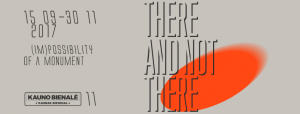Contested Memory | Contested Spaces
Curated by Dr. Rasa Antanavičiūtė
16–17 September 2017 Vytautas Magnus University, V. Putvinskio g. 23, Kaunas
26 October 2017 National Gallery of Art, Konstitucijos pr. 22, Vilnius
When discussing monuments and commemoration we have to talk about two fundamental interrelated aspects of this phenomenon: what are we commemorating and how should we commemorate it? Although a list of monument-deserving heroes raises questions and is by no means exaustive, in our oral programme we want to focus on the second aspect – how? During the first Biennial weekend researchers and artists will answer questions such as: What form might a contemporary monument take? How does the shape of the monument affect its content? How to create monuments of national importance that reach consensus between politicians, society and artists? Why do politicians and the general public still prefer traditional figurative monuments? How do Western societies react to new forms of commemoration?
The aim of the oral programme is to inform decision-makers, art and culture researchers, artists, students, public figures and interested members of the public about the many different examples of alternative forms of remembrance in other countries. The programme responds to debatable commemoration projects planned for the occasion of the Centenary of the modern Lithuanian State and aims to deconstruct prevailing mechanisms of memory “management” by revealing their political and cultural links. Together with the 11th Kaunas Biennial the oral programme opposes populist and conservative traditionalism in the practice of monument-building in Lithuania and seeks to encourage and legitimise contemporary conceptual ideas and strategies of commemoration.
The participants of the oral programme are a contemporary commemoration dream team – cultural theorist James E. Young, artist Jochen Gerz, and the artist duo Horst Hoheisel and Andreas Knitz. The oral programme will not only include presentations by these established researchers and artists, but also the first public discussion between them about commemorative culture and its new directions.
Session I
16 September (Sat) 11.00–12.30
Prof. James E. Young (University of Massachusetts Amherst)
Presentation (45 min.), discussion with Prof. Dr. Giedrė Jankevičiūtė (Lithuanian Culture Research Institute) and Q&A (45 min.) Moderated by Dr. Rasa Antanavičiūtė (art historian, 11th Kaunas Biennial oral programme curator)
University of Massachusetts Amherst professor James E. Young (www.umass.edu/english/member/james-e-young) is one of the most sought after jury members in major international memorial competitions. He has participated in the judging and building of such commemoration projects as the Memorial to the Murdered Jews of Europe in Berlin (2005) and the National September 11 Memorial in New York (2011). Young is the author of the fundamental studies on new forms of monuments (The Texture of Memory, Yale University Press, 1993; The Stages of Memory: Reflections on Memorial Art, Loss, and the Spaces Between, University of Massachusetts Press, 2016), is the inventor of the term counter memorials, and has acted as curator and consultant for many monument projects across the globe.
Session II
16 September (Sat) 14.00–16.30
Horst Hoheisel and Andreas Knitz presentation and discussion with Dr. Rasa Antanavičiūtė (45 min.)
Jochen Gerz presentation and discussion with Manca Bajec (Royal College of Art and Design) (45 min.)
Discussion: Jochen Gerz, Horst Hoheisel and James E. Young, moderated by Dr. Rasa Antanavičiūtė and Manca Bajec (1 h.)
Horst Hoheisel and Andreas Knitz (www.knitz.net) are the artists behind such projects as A Memorial to a Memorial (1995) in Buchenwald and Moving Monuments or the Monument of the Grey Buses in Ravensburg, Weissenau and Berlin (2006-2008). It was their proposal to demolish the Brandenburg Gate in Berlin for the Memorial to the Murdered Jews of Europe competition, and they projected onto it the famous phrase “Arbeit macht frei” from the entrance gate to the Auschwitz concentration camp in commemoration of the camp’s liberation (1997). Since the 1990s Hoheisel and Knitz have been creating radical monuments and commemoration projects, more than 40 of which have been realised in different countries around the world.
Artist Jochen Gerz (www.jochengerz.eu) became famous in 1986 when he and Esther Shalev-Gerz created a monument against fascism in Hamburg-Harburg (Germany), which became the set example for new forms of monuments. Since then he has realised more than thirty commemorative projects in public spaces. Most of them, such as the 2146 Stones – Monument Against Racism in Saarbrücken (1993), are based on the principle of participation and, above all, seek to create monuments in our imagination.
Session III
17 September (Sun) 12.00–15.00
Prof. Matthew Rampley (University of Birmingham)
Presentation (45 min.)
Manca Bajec (Royal College of Art and Design)
Presentation (45 min.)
Discussion: Matthew Rampley and Manca Bajec with Assoc. Prof. Dr. Giedrė Mickūnaitė (Vilnius Academy of Arts) (30 min.), followed by a Q&A with the speakers and the curators of the 11th Kaunas Biennial – Paulina Pukytė, Laima Kreivytė and Udi Edelman.
Art historian Matthew Rampley from the University of Birmingham (www.birmingham.ac.uk/staff/profiles/historyofart/rampley-matthew.aspx), editor of Heritage, Ideology and Identity in Central and Eastern Europe. Contested Pasts, Contested Presents (Boydell & Brewer, 2012), researcher of contemporary art and 20th century central European art and architecture, will look at the challenges of history and the politics of memory and commemoration in central Europe after the 1990s.
PhD student at the Royal College of Art and Design, artist and curator Manca Bajec (www.rca.ac.uk/news-and-events/events/fine-art-talk-manca-bajec), who researches the history of monument revisionism in the former Yugoslavia and artistic practice as a method of reconciliation, will share her thoughts on how/if art can not only comment on the current situation but also stimulate real social change. The speaker will ask if contemporary art can only offer new ideas to like-minded audiences or whether it can inspire new dialogues between people who generally are not considered to be contemporary art audiences?
Session IV
26 October (Thur) 18.00–20.00
Closing discussion with the curators of the 11th Kaunas Biennial, Paulina Pukytė, Laima Kreivytė and Dr. Rasa Antanavičiūtė, as well as cultural researcher Dr. Skaidra Trilupaitytė, Dr. Linara Dovydaitytė and others.
To attend please register with: Neringa Stoškutė / neringa@biennial.lt / +37062998182


